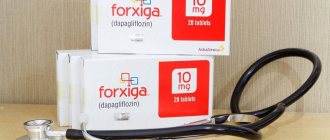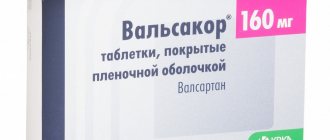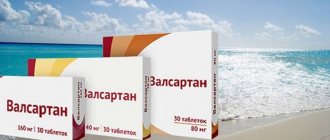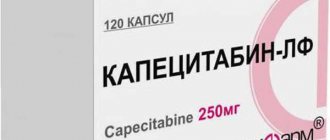Compound
Contains the active substance chlorpromazine hydrochloride .
The dragee contains 50 or 100 mg of this substance. Auxiliary elements: sunflower oil, talc, gelatin, sucrose, wax, starch syrup, titanium dioxide, iron oxide.
The solution contains 25 mg of chlorpromazine per 1 ml.
Tablets contain 25, 50 or 100 mg of active substance in the form of hydrochloride. Auxiliary elements are: magnesium stearate, cellulose, copovidone, starch, lactose monohydrate, croscarmellose sodium.
Pharmacodynamics and pharmacokinetics
The active component is a phenothiazine derivative. The drug has antiemetic, sedative, antipsychotic, weak hypothermic, vasodilating, local irritant, and moderate anticholinergic effects.
The antipsychotic effect is achieved by blockade of dopamine D2 receptors in the mesocortical and mesolimbic systems. The antipsychotic effect is manifested in the elimination of delusions, hallucinations and other productive symptoms of psychosis.
Aminazine helps relieve various types of psychomotor agitation, reduces the severity of psychotic fear and aggressiveness. The sedative effect is achieved by blocking the adrenergic receptors of the reticular pharmacy, located in the brain stem.
The drug inhibits conditioned reflex activity (especially motor-defensive receptors), reduces the spontaneity of motor activity, reduces sensitivity to exogenous and endogenous stimuli while maintaining consciousness, and relaxes skeletal muscles. Prescribing large dosages causes drowsiness.
Blockade of dopamine D2 receptors in the vomiting center in the trigger zone , as well as blockade of the vagus nerve in the gastrointestinal tract provide an antiemetic effect. Aminazine has a weak effect on m-cholinergic receptors, a pronounced effect is observed on alpha-adrenergic receptors.
The medication is able to completely eliminate the effects caused by epinephrine . The hypothermic effect is provided by blockade of dopamine receptors located in the hypothalamus. The medication increases heart rate, lowers blood pressure, has a pronounced cataleptogenic effect , a weak antihistamine effect, and reduces the permeability of capillary walls. When dopamine receptors are blocked, the production of prolactin by the pituitary gland increases. With intramuscular administration, the sedative effect develops after 15 minutes, with oral administration - after 2 hours. Tolerance to the hypotensive and sedative effects develops after 1 week.
When taken orally, the antipsychotic effect is observed on days 4-7. The most pronounced therapeutic effect lasts from 6 weeks to six months.
Pharmacological properties of the drug Aminazin
Chlorpromazine is an antipsychotic of the group of aliphatic phenothiazine derivatives. It has a pronounced antipsychotic effect, eliminates psychomotor agitation, reduces feelings of fear, aggressiveness, and psychomotor retardation. In addition to neuroleptic and sedative, it exhibits antiemetic, hypothermic, hypotensive, antihistamine and antiserotonin effects. Blocks central and dopaminergic interneuron contacts. Potentiates the effect of analgesics, local anesthetics, hypnotics and anticonvulsants. Pharmacokinetics. Chlorpromazine is metabolized in the liver, forming both active and inactive metabolites. It is excreted in urine and feces, passes through the BBB, and its concentration in the brain exceeds the concentration in the blood plasma. The half-life is quite long (4 weeks or more).
Indications for use of Aminazin
In psychiatric practice, the drug is used in the treatment of psychomotor agitation in patients with schizophrenia . The drug is prescribed for chronic psychosis, hypomanic agitation, acute delusional states, psychopathy, insomnia, anxiety, mental illnesses accompanied by agitation, anxiety, fear, for which tablets are often used.
Also, indications for the use of Aminazin are: alcoholic psychosis , persistent hiccups , “indomitable” vomiting, nausea. For persistent pain, the drug enhances the effect of analgesic medications.
The medicine is prescribed for diseases accompanied by increased muscle tone: tetanus (combination therapy with barbiturates), after suffering cerebrovascular accidents.
Previously, Aminazine was used as part of “lytic” mixtures (for artificial hypothermia ).
In anesthesiology, medication is prescribed to potentiate general anesthesia and for premedication .
In dermatological practice, the drug is used for itchy dermatoses . The drug is prescribed for the treatment of acute “intermittent” porphyria .
Contraindications to the use of the drug Aminazine
For liver damage (cirrhosis, hepatitis, hemolytic jaundice), kidney (nephritis, acute pyelitis, renal amyloidosis, urolithiasis), for blood diseases, progressive systemic diseases of the brain and spinal cord (slow neuroinfections, for example multiple sclerosis), for peptic ulcer of the stomach and duodenum during an exacerbation, decompensated heart defects, severe hypotension, thromboembolic diseases, severe myocardial dystrophy, late stage rheumatic carditis, bronchiectasis. This drug should not be prescribed to patients in a comatose state, including in cases associated with the use of barbiturates, alcohol, and drugs. Aminazine should not be used to eliminate agitation in acute brain injuries.
Contraindications
Aminazine is not used in comatose states of any etiology, with severe depression of the functions of the nervous system, with severe pathology of the cardiovascular system, with intolerance to the active substance, with progressive diseases of the spinal cord and brain of a systemic nature, with breastfeeding, with ulcerative lesions of the digestive tract .
Due to the risk of developing hepatotoxic reactions, Aminazine is prescribed with caution for alcoholism. For breast cancer, pathological changes in the blood, prostatic hyperplasia , angle-closure glaucoma, Parkinson's disease, myxedema, epilepsy, vomiting, cachexia, Reye's syndrome, and elderly patients, the drug is prescribed with caution.
Aminazine, 100 mg, film-coated tablets, 10 pcs.
During treatment, it is necessary to regularly monitor blood pressure, pulse, liver and kidney function. It is also necessary to monitor the blood picture (at first weekly, and then every 3-4 months); if during therapy the number of leukocytes decreases to 3.0-3.5x109/l, and the number of neutrophils decreases to 1.5-2.0x109/l, these indicators should be monitored 2 times a week; if leukocytosis and granulocytopenia occur, treatment should be interrupted.
Each patient should be informed that if they have a fever, sore throat or other manifestations of infectious diseases, they should immediately notify their doctor. In the event of hyperthermia, which may be one of the symptoms of neuroleptic malignant syndrome (pallor, hyperthermia, autonomic dysfunction, changes in consciousness, muscle rigidity), the drug Aminazine should be discontinued immediately. Early manifestations preceding the onset of hyperthermia may include side effects such as increased sweating and instability of blood pressure (BP). Although the etiology of the dependence of such side effects on antipsychotics is most often unknown, there are a number of risk factors: individual predisposition, dehydration, organic brain damage. Neuroleptic malignant syndrome can occur at any time during treatment with antipsychotic drugs and can be fatal.
If signs and symptoms of tardive dyskinesia occur, consider reducing the dose or discontinuing all antipsychotic medications. Tardive dyskinesia sometimes occurs after discontinuation of the antipsychotic and disappears with repeated use or increased dosage. Prescription of antiparkinsonian and anticholinergic drugs in the development of tardive dyskinesia is contraindicated (the condition may worsen).
Antiparkinsonian drugs - trihexyphenidyl and others - are used as correctors for extrapyramidal disorders, the occurrence of which is possible with the use of the drug Aminazin®.
Aminazine®, depending on the dose, may increase the prolongation of the QT interval, which increases the risk of ventricular arrhythmias, including the “pirouette” type. Bradycardia, hypokalemia, and congenital or acquired long QT period also increase. Therefore, before starting treatment, you must ensure that:
- bradycardia below 55 beats per minute;
- hypokalemia;
- congenital prolongation of the QT interval.
Except in emergency situations, it is recommended to perform an ECG during the preliminary examination of patients requiring treatment with an antipsychotic.
In randomized clinical trials in elderly patients with dementia, atypical antipsychotic drugs (AEDs) were found to have an increased risk of stroke compared with placebo. The mechanism for this increased risk is not known. An increased risk with other antipsychotics or in other age groups cannot be excluded. Aminazine should be used with caution in patients with risk factors for stroke, in elderly patients with dementia, since the risk of mortality increases in elderly patients with psychoses associated with dementia and receiving antipsychotic drugs. Placebo-controlled studies, which were conducted primarily in patients taking atypical antipsychotic drugs, showed a 1.6- to 1.7-fold increased risk of mortality compared with placebo. At the end of treatment, lasting an average of 10 weeks, the risk of mortality was 4.5% in the chlorpromazine group, compared with 2.6% in the placebo group. Although the causes of death in clinical studies with atypical antipsychotics varied, the majority of these deaths were the result of cardiovascular problems (eg, heart failure, sudden death) or infections (eg, pneumonia).
There is a risk of venous thromboembolism (VTE) during treatment with antipsychotics. In patients receiving antipsychotic drugs, especially those with acquired risk factors for VTE, preventive measures should be taken and any potential risk factor for VTE should be assessed before and during treatment with Aminazine®.
Except in exceptional circumstances, Aminazine® should not be used in Parkinson's disease.
The occurrence of intestinal obstruction, which can be detected by bloating and abdominal pain, requires emergency care.
Predisposing factors for the development of arrhythmia when taking Aminazin® are: hypokalemia (including when using diuretics that cause hypokalemia), bradycardia (including those caused by drugs), an existing (congenital or acquired) increase in the duration of the QT interval. The simultaneous administration of chlorpromazine with dopaminergic non-antiparkinsonian drugs (cabergoline, quinagolide) is not recommended due to the mutual antagonism of dopamine agonists and antipsychotics. Concomitant use with other antipsychotics that can cause irritation (amisulpride, cyamemazine, droperidol, fluphenazine, propericiazine, haloperidol, levomepromazine, pimozide, pipamperone, pipothiazine, sertindole, sulpiride, sultopride, tiapride) is not recommended. Concomitant use with antiparasitic drugs (halofantrine, lumefantrine, pentamidine) is not recommended. Also, simultaneous use with antifungal agents from the azole group is not recommended (increased risk of arrhythmia). If it is impossible to avoid the co-administration of the above combinations, it is recommended to carry out regular ECG monitoring with monitoring of the duration of the QT interval. When using non-potassium-sparing diuretics, correction of hypokalemia and ECG monitoring are necessary before starting chlorpromazine therapy.
Monitoring during treatment with Aminazine should be intensified:
- in patients with epilepsy and a history of seizures, due to the possibility of lowering the seizure threshold. The occurrence of seizures requires cessation of treatment.
- in elderly patients with:
a) high susceptibility and effect of orthostatic hypotension (increased risk of excessive sedation and hypotensive effects),
b) chronic constipation (risk of paralytic intestinal obstruction),
c) possible prostate hypertrophy;
- in patients with cardiovascular diseases taking quinidine, due to a possible increase in the hypotensive effect;
- in case of liver failure and/or severe renal failure, due to the risk of accumulation.
For long-term treatment, regular ophthalmological monitoring is recommended.
It should be taken into account that the use of phenothiazine derivatives can lead to hyperglycemia or impaired glucose tolerance, development or exacerbation of diabetes mellitus, hypercholesterolemia, fecal impaction, severe intestinal obstruction and megacolon.
Since in high doses (100 mg/day) chlorpromazine can cause an increase in blood glucose levels by reducing insulin secretion, in patients with diabetes mellitus it is necessary to adjust insulin doses before and after completion of therapy. If necessary, the dose of the antipsychotic should also be adjusted in patients taking sulfonylureas.
Chlorpromazine should not be used as monotherapy if depression predominates.
Aminazine® should be used with caution in case of hypersensitivity to other phenothiazine drugs or severe respiratory diseases.
Due to the risk of photosensitivity, ultraviolet irradiation should be avoided.
Aminazine® can worsen the course or promote the manifestation of latent myasthenia gravis, as well as cause myasthenic syndrome.
To avoid the development of withdrawal syndrome, it is necessary to stop treatment with Aminazin® gradually.
The mutual antagonism of levodopa and antipsychotics must be taken into account. Dopamine may cause or worsen psychotic disorders. To treat patients suffering from parkinsonism, it is necessary to use minimal effective doses of both drugs. If it is necessary to treat patients with parkinsonism treated with dopamine with antipsychotics, the dose of the latter should be reduced gradually to a minimum (abrupt withdrawal of dopamine may increase the risk of developing “neuroleptic malignant syndrome”).
In patients with pheochromacetoma taking Aminazine®, false positive results of catecholamine levels in the blood may be observed.
During therapy, it is necessary to stop drinking alcohol, since chlorpromazine enhances the inhibitory effect of alcohol on the central nervous system.
Impact on the ability to drive vehicles and operate machinery:
During the treatment period, it is necessary to refrain from engaging in potentially hazardous activities that require increased concentration and speed of psychomotor reactions.
Side effects of Aminazine
Let's look at the side effects of Aminazine. At the first stages of therapy, dry mouth, increased drowsiness , accommodation paresis, constipation, dizziness, appetite disturbances, tachycardia, a severe form of orthostatic hypotension, decreased potency, urinary retention, sleep disorders, allergic reactions , frigidity , drop in blood pressure are noted.
Long-term therapy with chlorpromazine causes neuroleptic depression , cramps of the tongue, neck muscles, floor of the mouth, extrapyramidal disorders , akathisia, akineto-rigid phenomena, delayed reaction to stimuli, mental changes, amenorrhea , hypercoagulation, inhibition of bone marrow hematopoiesis, cardiac arrhythmias, cholestatic jaundice, gynecomastia, hyperplolactinemia , galactorrhea, skin pigmentation, oliguria, diarrhea, vomiting, neuroleptic malignant syndrome. When administered intramuscularly, infiltrates may form; with intravenous infusion - phlebitis .
Instructions for use of Aminazin (Method and dosage)
The drug is taken orally, administered intramuscularly, intravenously.
Aminazine tablets, instructions for use
The initial daily dosage in psychiatric practice is 25-100 mg (for 1-4 doses). Gradually, the amount of the drug is increased every 3-4 days by 25-50 mg until the desired effect is achieved. In case of anxiety before surgical interventions, the medication is prescribed 2-3 hours before surgery. The maximum one-time intake is 300 mg, per day - 1.5 g.
Solution
A 2.5% solution is administered intravenously and intramuscularly.
The initial dose is 25-50 mg. Before intramuscular administration, the drug solution is diluted in 2-5 ml of procaine (0.25-0.5%), or in a 0.9% sodium chloride solution. Aminazine is administered deeply intramuscularly. Before surgical interventions in cases of anxiety, patients are administered the drug intramuscularly at the rate of 0.55 mg per 1 kg of weight 2 hours before the intended surgical treatment. For tetanus, 0.55 mg/kg is administered intramuscularly every 8 hours, the infusion rate is 1 mg/2 minutes.
Maximum one-time intramuscular injection is 150 mg, per day - 1 g.
The maximum one-time intravenous dose is 100 mg, per day - 250 mg.
In pediatric practice, only special, pediatric forms of the drug are used.
When is use indicated?
The main indications for treatment with Aminazine.
- various mental disorders in schizophrenia, manic-depressive psychosis;
- psychoses of various types;
- other types of mental disorders;
- constant anxiety, psychopathy, timidity;
- severe sleep disturbance;
- epilepsy and other similar disorders of the central nervous system;
- alcohol withdrawal syndrome and delirium delirium;
- uncontrollable hiccups and vomiting;
- preparing surgical patients for surgical interventions;
- dermatoses, accompanied by very strong and indomitable itching.
The use of Aminazine in chronic alcoholism should be very careful, because such a combination can adversely affect the condition of the liver.
Treatment with Aminazin is strictly contraindicated for oncological pathologies, parkinsonism, and glaucoma.
Overdose
An overdose is manifested by blurred visual perception, hyperreflexia or areflexia . Cardiotoxic effects in the form of shock, drop in blood pressure, development of heart failure , arrhythmia, cardiac arrest, ventricular fibrillation, and changes in the QRS complex on the electrocardiogram are also noted
Neurotoxic effects include coma, stupor, drowsiness, disorientation , convulsions, confusion, agitation, respiratory depression, pulmonary edema, vomiting, muscle rigidity, hypothermia, or hyperpyrexia .
The administration of enterosorbents and gastric lavage are required. When arrhythmia develops, phenytoin is administered intravenously; when heart failure develops, the use of cardiac glycosides . When blood pressure drops, vasopressors ( phenylephrine , norepinephrine) are given intravenously. Diazepam is indicated for the development of seizures. Diphenhydramine and diphenyltropine are effective for parkinsonism For five days, control over the functioning of the cardiovascular system and respiratory system is required, and consultation with a psychotherapist is required. Dialysis has not proven effective.
General symptoms of drug poisoning
The lethal dose for Aminazine poisoning is 5 g. There are known cases of death from 0.5 grams of the drug and recovery after taking 6 or more grams of the drug. The child's body is more sensitive to psychotropic drugs of the neuroleptic series. For them, a lethal dose can be 0.25 grams of the drug or even less.
The pathogenesis of poisoning is a disruption of the nervous system. Loss of consciousness is caused by inhibition of the cerebral cortex, inhibition of reflex conductivity.
Symptoms of acute poisoning with Aminazine:
- severe drowsiness and extreme weakness;
- dizziness;
- ataxia;
- anorexia;
- absence of bowel movements;
- nausea (manifested as a result of severe irritation of the mucous membrane in the stomach);
- a sharp increase in heart rate (sometimes it can be thread-like, that is, difficult to detect);
- drop in blood pressure (sometimes patients experience so-called orthostatic collapse);
- severe allergic reactions (in some cases they can lead to swelling of the larynx and breathing problems);
- urinary retention (it leads to progressive poisoning of the body with decay products).
In case of severe poisoning, loss of consciousness occurs very early, breathing changes according to the Cheyne-Stokes type. The skin becomes pale, almost dry. Hyperreflexia appears against the background of further clouding of consciousness. Severe and prolonged tonic or clonic convulsions occur. Such phenomena tend to repeat themselves.
Further progression of poisoning causes the onset of a coma. At first it is shallow, but later the intensity of the reflexes decreases. Severe coma contributes to the development of paralysis of the respiratory center with a fatal outcome. Death from such poisoning is not immediate; it often develops over several days.
Complications:
- Orthostatic type collapse.
- Liver dystrophy.
- Acute liver failure.
- Acute kidney failure.
- Brain swelling.
- Pulmonary edema.
- Acute inflammation of the lung tissue.
- Acute allergic reactions.
Interaction
Aminazine may weaken the vasoconstrictor effect of the drug Ephedrine . Some manifestations of ototoxicity (severe dizziness, tinnitus) when taking ototoxic medications may be masked during treatment with chlorpromazine.
The drug reduces the severity of the antiparkinsonian effect of levodopa (as a result of blockade of dopamine receptors). A similar effect is observed when taking clonidine , amphetamine, and guanethidine.
The medication enhances the anticholinergic effect of other drugs, but at the same time there is a decrease in its own antipsychotic effect. The medication is compatible with antidepressants , antipsychotics, and anxiolytics. Long-term use of antipyretics and analgesics is not recommended due to the risk of hyperthermia .
The risk of developing neuroleptic malignant syndrome increases significantly when combined with tricyclic antidepressants, MAO inhibitors, and manprotiline.
Lithium preparations, antiparkinsonian drugs, antacid medications interfere with the absorption of chlorpromazine.
special instructions
Therapy with the drug requires control over the pulse, blood pressure, and the functioning of the hepatic and renal systems. To prevent a sharp drop in blood pressure after intravenous and intramuscular injections, the patient is placed on the couch for 1.5-2 hours.
Due to the fact that the drug can cause photosensitivity , it is recommended to avoid ultraviolet rays and radiation. Ethanol intake is not allowed during therapy. It is necessary to completely eliminate the possibility of chlorpromazine getting on mucous membranes and skin.
The drug affects driving.
Described on Wikipedia as Chlorpromazine.
INN: Chlorpromazine.
Recipe in Latin:
Rp.: Sol. Aminazini 2.5% 1.0 D. td N 10 in amp. S.
Use during pregnancy and breastfeeding
If it is necessary to use chlorpromazine during pregnancy, the duration of treatment should be limited, and at the end of pregnancy, if possible, the dose should be reduced. It should be borne in mind that chlorpromazine prolongs labor.
If use is necessary during lactation, breastfeeding should be discontinued.
Chlorpromazine and its metabolites penetrate the placental barrier and are excreted in breast milk.
Clinical studies have shown that chlorpromazine may have a teratogenic effect. When chlorpromazine was used in high doses during pregnancy in newborns, in some cases, digestive disorders associated with atropine-like effects and extrapyramidal syndrome were observed.
Reviews about Aminazine
The drug has a very powerful effect, helping to eliminate signs of psychomotor agitation. However, reviews of Aminazine are very different.
Some people maintain that the drug is very effective for schizophrenia, Alzheimer's disease, epilepsy, psychosis, and relieves stress and anxiety. Others consider the drug sometimes even simply terrible; they say that it provokes epileptic seizures, hand tremors, a state of increased drowsiness, and various personality disorders.
In any case, this medication should only be used under the supervision of a physician.
Poisoning in children
Signs of intoxication with the drug in question in children are almost the same as in adults. Characterized by a very slow and gradual increase in symptoms. At the beginning of poisoning, nausea increases, which is then joined by vomiting. The main symptom of the disease is apathy and lethargy of the child. He can be very sleepy: if you wake him up, he later falls asleep again.
In case of moderate poisoning, the child develops anxiety and grimacing. In later stages, loss of consciousness occurs. Reflexes are almost completely lost. Lack of treatment significantly increases the risk of death.
Video: doctor's reviews of the drug Aminazine.
Aminazine price, where to buy
A package of 10 ampoules of 2 ml 25 mg/ml costs approximately 60 rubles.
10 tablets of 25 mg cost about 150 rubles.
The price of Aminazin in tablets is approximately 70 rubles per package of 10 pieces of 100 mg.
- Online pharmacies in RussiaRussia
- Online pharmacies in UkraineUkraine
- Online pharmacies in KazakhstanKazakhstan
ZdravCity
- Aminazine solution for intravenous and intramuscular administration.
2.5% 2ml 10 pcs. JSC Novosibkhimpharm 196 rub. order - Aminazine tablets p.p.o. 50 mg 10 pcs. PJSC Valenta Pharm/JSC Valenta Pharmaceuticals/JSC Valenta Pharm
RUB 244 order
- Aminazine tablets p.p.o. 25 mg 10 pcs. PJSC Valenta Pharm/JSC Valenta Pharmaceuticals/JSC Valenta Pharm
RUB 137 order
- Aminazine tablets p.p.o. 100 mg 10 pcs. JSC Valenta Pharmaceuticals
RUB 281 order
Pharmacy Dialogue
- Aminazine (tab.p.pl/vol. 25 mg No. 10) Valenta Pharmaceuticals OJSC
145 rub. order
- Aminazine (tab.p.pl/vol. 50 mg No. 10) Valenta Pharmaceuticals OJSC
RUB 232 order
show more
Pharmacy24
- Aminazine 2.5% 2 ml N10 injection solution PAT "Galichfarm", Ukraine
34 UAH. order
PaniPharmacy
- Aminazine ampoule Aminazine solution d/in. 2.5% amp. 2ml No. 10 Ukraine, Galichfarm JSC
30 UAH order
- Aminazine tablet. p/o 0.1g No. 10 in pack.
61 UAH order
- Aminazine ampoule Aminazine solution d/in. 2.5% amp. 2ml No. 10 Ukraine, Health of the people LLC
25 UAH order
- Aminazine tablets Aminazine tablets. p/o 0.025g No. 20 Ukraine, Health LLC
52 UAH order
- Aminazine tablets Aminazine tablets. p/o 0.1g No. 10 Ukraine, Health LLC
44 UAH order
show more







